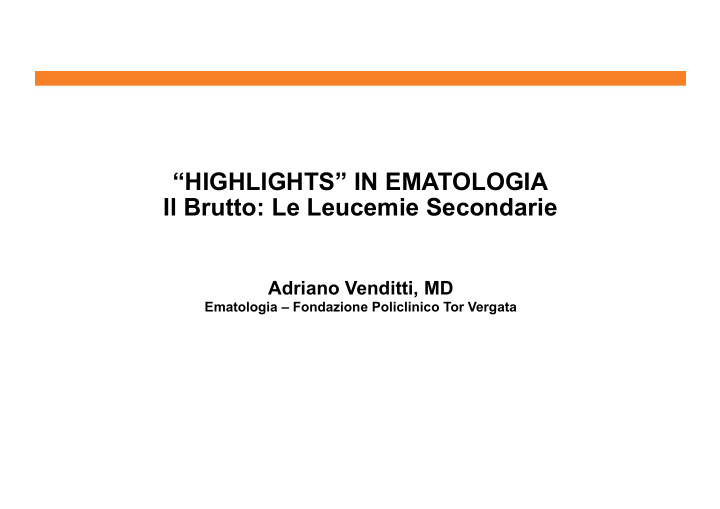



“HIGHLIGHTS” IN EMATOLOGIA Il Brutto: Le Leucemie Secondarie Adriano Venditti, MD Ematologia – Fondazione Policlinico Tor Vergata
Agenda • Biologic considerations • Therapeutic approach
WHO Classification (2016) AML categories: • AML with recurrent genetic abnormalities • AML with myelodysplasia-related changes (MRC) • Therapy-related AML/MDS • AML not otherwise specified (NOS) • Myeloid sarcoma • Myeloid proliferations related to Down syndrome MDS, myelodysplastic syndrome; WHO, World Health Organization Arber DA, et al. Blood. 2016;127(20):2391-2405
WHO 2016 AML Classification Cytogenic Abnormalities Complex karyotype (3 or more abnormalities) AML with MDS related changes: Unbalanced abnormalities • 50% dysplasic cells in 2 lines –7/del(7q) del(5q)/t(5q) • History of MDS i(17q)/t(17p) • MDS-related cytogenetics (except del9q) –13/del(13q) del(11q) del(12p)/t(12p) idic(X)(q13) Balanced Abnormalities t(11;16)(q23.3;p13.3) t(3;21)(q26.2;q22.1) t(1;3)(p63.3;q21.2) t(2;11)(p21;q23.3) t(5;12)(q32;p13.2) t(5;7)(q32;q11.2) t(5;17)(q32;p13.2) t(5;10)(q32;q21.2) t(3;5)(q25.3;q35.1) Arber DA, et al. Blood. 2016;127(20):2391-2405..
AML is Primarily a Disease of Older Adults 25 20 15 Incidence (Per 100,000) 10 5 0 <1 1-4 5-9 10- 15- 20- 25- 30- 35- 40- 45- 50- 55- 60- 65- 70- 75- 80- 85+ 14 19 24 29 34 39 44 49 54 59 64 69 74 79 84 Age at Diagnosis (Years) AML, acute myeloid leukemia SEER Cancer Statistics Review. 1975-2000. http://seer.cancer.gov/csr/1975_2000/results_merged/sect_13_leukemia.pdf. Accessed 23 May 2018.
Incidence of AML and Age in Italy Age 0-54 Age 55-64 Age 65+ AIRTUM Working Group, et al. Epidemiol Prev. 2016;40(1 Suppl 2):1-20
Cytogenetic Categories and Age in AML Grimwade D, et al. Blood. 2001;98(5):1312-1320
Age-Related Frequency of Selected Recurring Gene Mutations NPM1 FLT3-ITD DNAMT3A RUNX1 IDH2 ASXL1 TET2 IDH1 TP53 IDH2 R140 CBPA Biallelic IDH2 R172 Bullinger L, et al. J Clin Oncol. 2017;35(9):934-946
• Can AML ontogeny be mutationally defined? • Is there any relationship between ontogenic models and age?
Ontogenic Models in AML: 3 Distinct Categories • De novo AML: Arises in absence of identified exposure or prodromal stem cell disorder • Secondary AML (sAML): Transformation of AHD • Therapy -related AML (tAML): Late complication in individuals with exposure to leukemogenic agents AHD, antecedent hematologic disorder
Frequency of Cytogenetic Aberrations in De Novo , sAML, and tAML Heuser M. Hematology Am Soc Hematol Educ Program. 2016;2016(1):24-32
AML Ontogeny Can Be Mutationally Defined Association with sAML with >95% specificity Association with sAML with <95% specificity Neutrality Association with de novo AML with <95% specificity Association with de novo AML with >95% specificity Lindsley RC, et al. Blood. 2015;125(9):1367-1376
Incidence of sAML Increases With Age Juliusson G, et al. Blood. 2012;119(17):3890-3899
Even in Clinically-Defined De Novo AML, sAML-Like Features Are Associated With Age Clinically-Defined De Novo AML P = .043 % Total CR, complete response Lindsley RC, et al. Blood. 2015;125(9):1367-1376
Algorithm for the treatment of t-MN Churpek & Larson, BPRCH 2013
Transplant outcome based on disease type before SAML S. Sengsayadeth et al. BBMT 24 (2018) 1406–1414
Poor Outcome of sAML and t-AML Patients <60 Years Time Since AML Diagnosis, Years Patients ≥ 60 Years Time Since AML Diagnosis, Years Granfeldt Østgard LS, et al. J Clin Oncol. 2015;33(31):3641-3649
CPX-351 Uses a Nano-Scale Delivery Complex ü 100-nm bilamellar liposomes ü 5:1 molar ratio of cytarabine to daunorubicin ü 1 unit = 1.0 mg cytarabine plus 0.44 mg daunorubicin Lancet JE, et al. ASCO 2016. Abstract 7000.
Lancet JE, et al. JCO 2018
Lancet JE, et al. JCO 2018
Lancet JE, et al. JCO 2018
Lancet JE, et al. JCO 2018
Lancet JE, et al. JCO 2018
CPX-351 life cycle development Extend use to other AML and hematologic malignancies
Conclusions-1 • sAML among the most difficult disease to treat • For patients who achieve an initial CR, ASCT represents the best chance for long-term OS • Need of continued development of novel agents
Conclusions-2 • The current list of disease-relevant genes is likely to expand • More chances to capture AML heterogeneity at a single-cell level • Advances in (personalized) treatment – Novel therapies
CLINICAL TRIALS IN THE «GENOMIC ERA» • Patients’ selection Relationship between mutations, malignancy and response to novel agents • Basket clinical trials Pooling together different cancers per their genomic pattern irrespective of their histologic origin (Histology-agnostic randomized trials) • Umbrella clinical trials Multiple targeted agents/drugs for a single histology (Beat AML – Master Clinical Trial) • Adaptive clinical trials Use of multiple interim analysis to adapt key features based on predefined rules
Recommend
More recommend